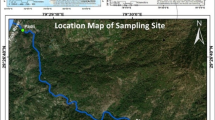Abstract
Using the methods of multivariate statistics, it was determined that the greatest species richness of mixotrophic river plankton in the region studied is characterized by the lower reaches of the Arctic rivers, and the maximum total density of mixotrophs is reached in the Kolyma Reservoir. It was found that among the complex of nutrients, ammonium ions, total iron, and total phosphorus had the strongest impact on the mixotrophs, and among the indices of organic matter, chemical oxygen consumption was most important. It is shown that the concentration of nutrients is more closely related to the total density of mixotrophs, and the content of organic matter is more closely related to the total number of species. The revealed dependence of the cell size of a number of mixotrophic species on the content of dissolved organic matter and nutrients is due to their feeding strategy.



Similar content being viewed by others
REFERENCES
Andersen, K.H., Berge, T., Goncalves, R.J., Hartvig, M., Heuschele, J., Hylander, S., Jacobsen, N.S., Lindemann, C., Martens, E.A., Neuheimer, A.B., Olsson, K., Palacz, A., Prowe, A.E.F., Sainmont, J., Traving, S.J., Visser, A.W., Wadhwa, N., and Kiorboe, T., Characteristic sizes of life in the oceans, from bacteria to whales, Ann. Rev. Mar. Sci., 2016, vol. 8, pp. 217–241. https://doi.org/10.1146/annurev-marine-122414-034144
Arenovski, A.L., The distribution, abundance and ecology of mixotrophic algae in marine and freshwater plankton communities, Thesis, 1994. https://doi.org/10.1575/1912/5582
Bondarenko, N.A. and Logacheva, N.F., Structural changes in phytoplankton of the littoral zone of Lake Baikal, Hydrobiol. J., 2017, vol. 53, pp. 16–24. https://doi.org/10.1615/HydrobJ.v53.i2.20
Chakraborty, S., Nielsen, L.T., and Andersen, K.H., Trophic strategies of unicellular plankton, Am. Nat., 2017, vol. 189, pp. 77–90. https://doi.org/10.1086/690764
Dai, C.-J., He, J.-F., Wang, G.-Z., and Li, S.-J., A review of ecological research on mixotrophic plankton, Acta Ecol. Sin., 2005, vol. 25, pp. 2399–2405.
Dittmar, T. and Kattner, G., The biogeochemistry of the river and shelf ecosystem of the Arctic Ocean: a review, Mar. Chem., 2003, vol. 83, pp. 103–120. https://doi.org/10.1016/S0304-4203(03)00105-1
Falkowski, P.G., Gan, R., and Wyman, K., Growth-irradiance relationships in phytoplankton, Limnol. Oceanogr., 1985, vol. 30, pp. 311–321. https://doi.org/10.4319/lo.1985.30.2.0311
Flynn, K.J., Stoecker, D.K., Mitra, A., Raven, J.A., Glibert, P.M., Hansen, P.J., Graneli, E., and Burkholder, J.M., Misuse of the phytoplankton—zooplankton dichotomy: the need to assign organisms as mixotrophs within plankton functional types, J. Plankton Res., 2013, vol. 35, pp. 3–11. https://doi.org/10.1093/plankt/fbs062
Gabyshev, V.A. and Gabysheva, O.I., Fitoplankton krupnykh rek Yakutii i sopredel’nykh territorii Vostochnoi Sibiri (Phytoplankton of Large Rivers of Yakutia and Adjacent Territories of Eastern Siberia), Novosibirsk: ANS SibAK, 2018.
Gerea, M., Saad, J.F., Izaguirre, I., Queimalinos, C., Gasol, J.M., and Unrein, F., Presence, abundance and bacterivory of the mixotrophic algae Pseudopedinella (Dictyochophyceae) in freshwater environments, Aquat. Microbiol. Ecol., 2016, vol. 76, pp. 219–232. https://doi.org/10.3354/ame01780
Goryunova, S.V., Patterns of the process of anthropogenic degradation of water bodies, Extended Abstract of Doctoral (Biol.) Dissertation, Moscow: Moscow Stat Univ., 2006.
Jones, R.I., Mixotrophy in planktonic protists: an overview, Freshwater Biology, 2000, vol. 45, no. 2, pp. 219–226. https://doi.org/10.1046/j.1365-2427.2000.00672.x
Korneva, L.G., Phytoplankton succession, in Ekologiya fitoplanktona Rybinskogo vodokhranilishcha (Ecology of Phytoplankton of the Rybinsk Reservoir), Tolyatti: Samar. Nauchn. Tsentr, 1999, pp. 89–148.
Korneva, L.G., Fitoplankton Vodokhranilishch basseina Volgi (Ecology of Phytoplankton of the Rybinsk Reservoir), Kostroma: Kostrom. Pechatnyi Dom, 2015, vol. 284.
Marañón, E., Cell size as a key determinant of phytoplankton metabolism and community structure, Ann. Rev. Mar Sci., 2015, vol. 7, pp. 241–264. https://doi.org/10.1146/annurev-marine-010814-015955
Morel, A. and Bricaud, A., Theoretical results concerning light absorption in a discrete medium, and application to specific absorption of phytoplankton, Deep Sea Res., Part A: Oceanogr. Res. Pap., 1981, vol. 28, pp. 1375–1393.https://doi.org/10.1016/0198-0149(81)90039-x
Olrik, K., Ecology of Peridinium willei and P. volzii (Dinophyceae) in Danish lakes, Nord. J. Bot., 1992, vol. 12, pp. 557–568. https://doi.org/10.1111/j.1756-1051.1992.tb01834.x
Olrik, K., Ecology of mixotrophic flagellates with special reference to Chrysophyceae in Danish lakes, Hydrobiologia, 1998, vols. 369–370, pp. 329–338. https://doi.org/10.1007/978-94-017-2668-9_28
Rosowski, J., Photosynthetic euglenoids, in Freshwater Algae of North America. Ecology and Classification, Elsevier: Academic, 2003, pp. 383–422.
Rothhaupt, K.O., Nutrient turnover by freshwater bacterivorous flagellates: differences between a heterotrophic and a mixotrophic chrysophyte, Aquat. Microbiol. Ecol., 1997, vol. 12, pp. 65–70. https://doi.org/10.3354/ame012065
Safonova, T.A., Evglenovye vodorosli Zapadnoi Sibiri (Euglenoid Algae of Western Siberia), Novosibirsk: Nauka, 1987.
Schoonhoven, E., Ecophysiology of Mixotrophs, 2000, pp. 1–35.
Sládečeková, A. and Sládeček, V., Bioindication within the aquatic environment, Acta Univ. Carolin. Environ., 1993, vol. 7, pp. 3–69.
Smith, L.C., MacDonald, G.M., Velichko, A.A., Beilman, D.W., Borisova, O.K., Frey, K.E., Kremenetski, K.V., and Sheng, Y., Siberian peatlands a net carbon sink and global methane source since the Early Holocene, Science, 2004, vol. 303, pp. 353–356. https://doi.org/10.1126/science.1090553
Stoecker, D.K., Conceptual models of mixotrophy in planktonic protists and some ecological and evolutionary implications, Eur. J. Protistol., 1998, vol. 34, pp. 281–290. https://doi.org./10.1016/s0932-4739(98)80055-2
Vincent, W. and Goldman, C., Evidence for algal heterotrophy in Lake Tahoe, California–Nevada, Limnol. Oceanogr., 1980, vol. 25, pp. 89–99. https://doi.org/10.4319/lo.1980.25.1.0089
Funding
The research was carried out within the state assignment of the Ministry of Science and Higher Education of the Russian Federation (theme no. 0297-2021-0026, reg. no. AAAA-A21-121012190036-6).
Author information
Authors and Affiliations
Corresponding author
Ethics declarations
The authors declare that they have no conflicts of interest. This article does not contain any studies involving animals or human participants performed by any of the authors.
Rights and permissions
About this article
Cite this article
Gabyshev, V.A., Gabysheva, O.I. Effect of the Concentration Gradient of Organic Matter and Nutrients on the Spatial Structure of Mixotrophic Phytophlagellate Plankton of Large East Siberian Rivers. Biol Bull Russ Acad Sci 49, 36–42 (2022). https://doi.org/10.1134/S1062359022020078
Received:
Revised:
Accepted:
Published:
Issue Date:
DOI: https://doi.org/10.1134/S1062359022020078




